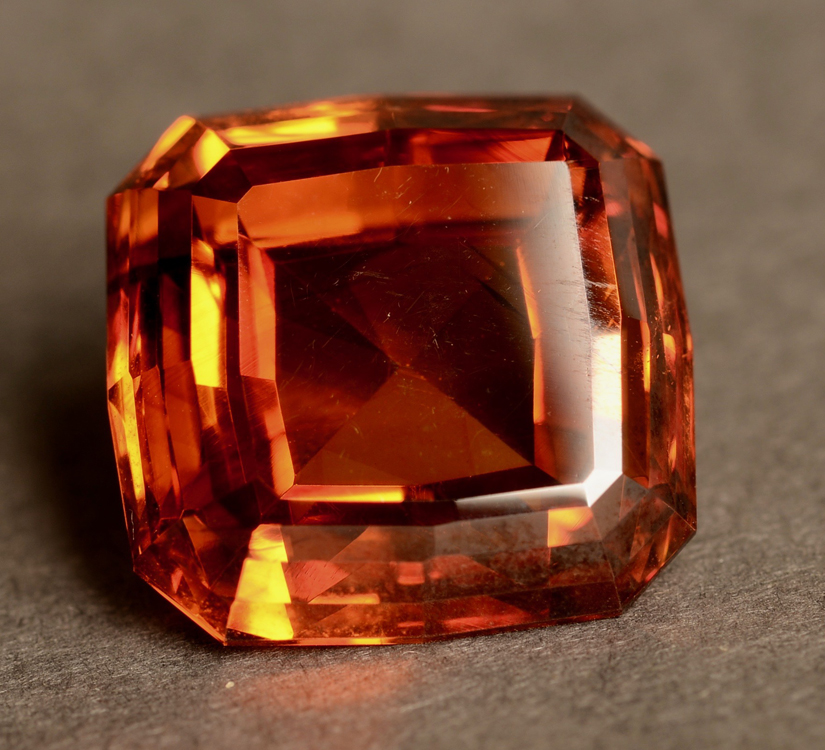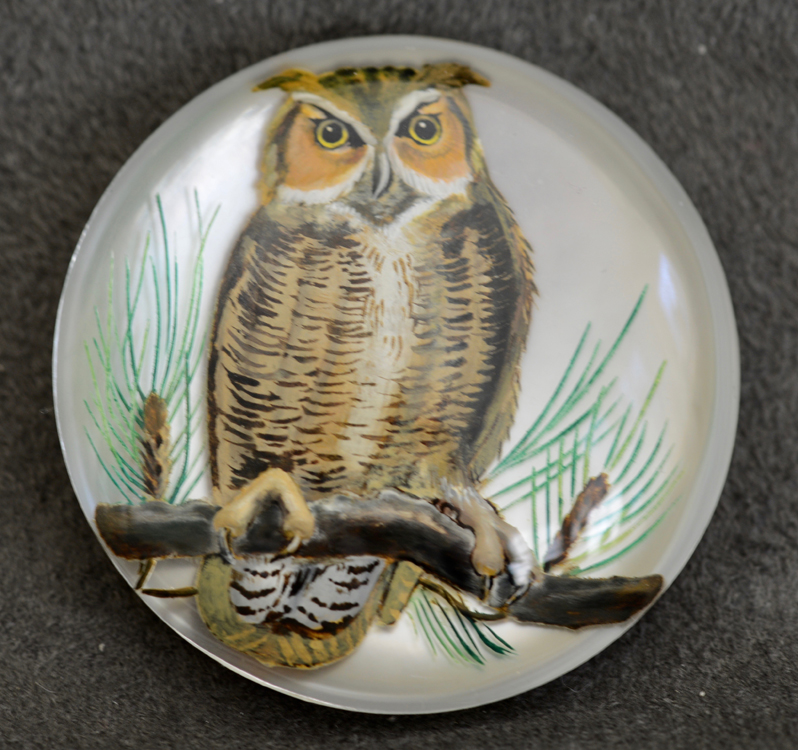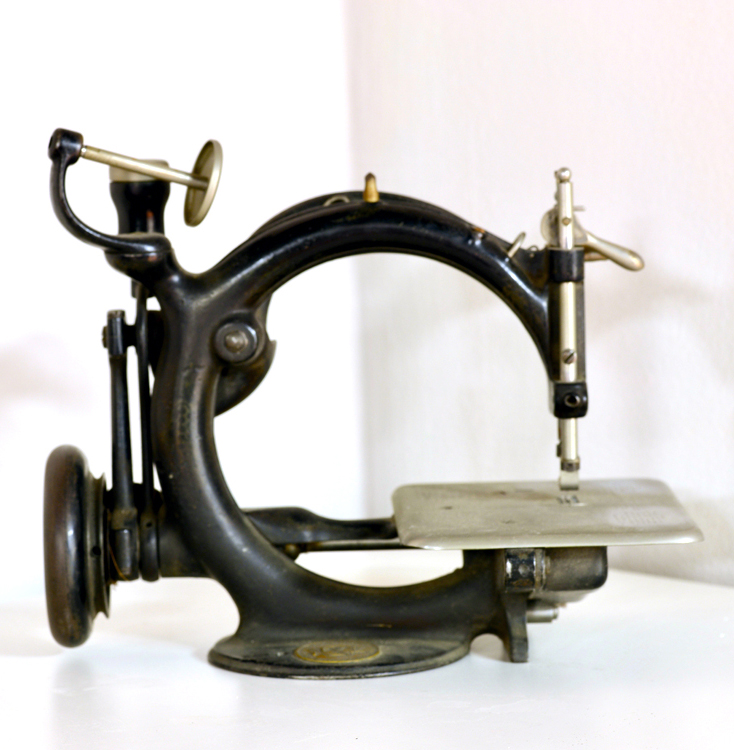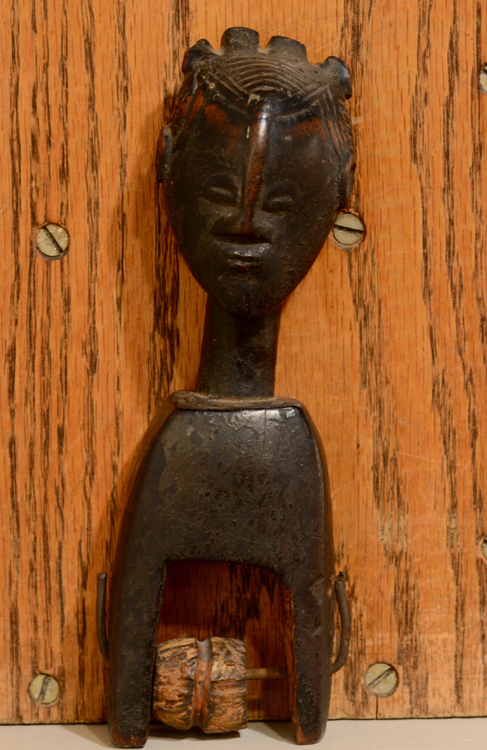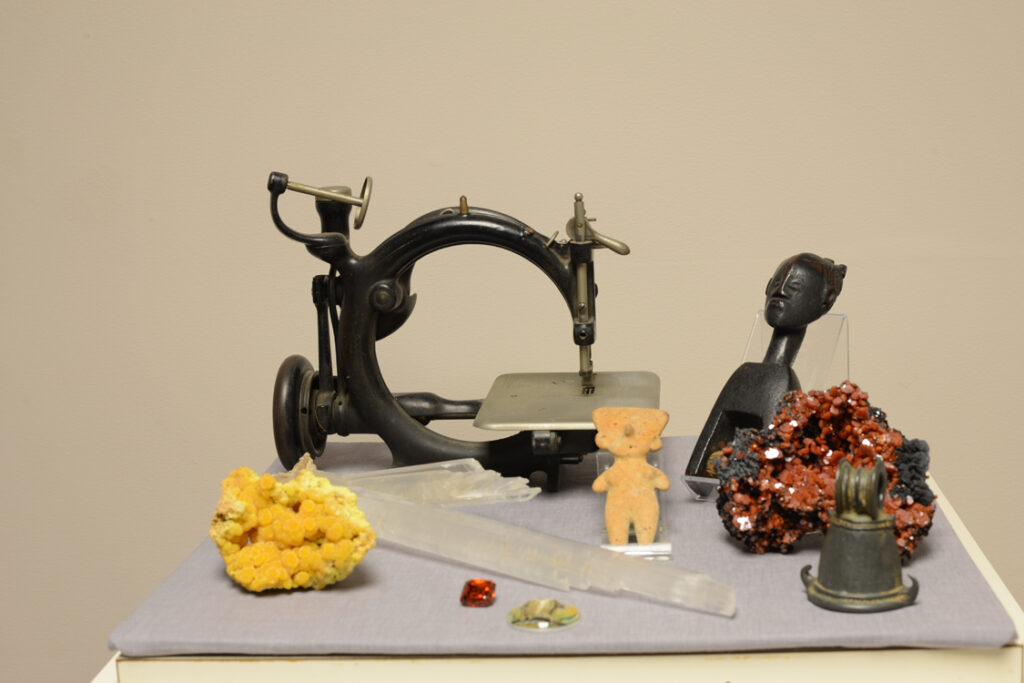
Although this exhibition is arranged thematically, where objects in the cases relate to one another, it is important to understand that collectors cabinets from the Italian Renaissance onward were arranged in a random fashion. Unrelated objects arrayed in a room, drawer, or cabinet spoke to the eclectic interests and idiosyncrasies of each specific collector. This case is designed to reflect this type of unplanned display and to act as a gateway of sorts in understanding the origins of these cabinets.
Mimetite
Congreso-Leon mine, San Pedro Corralitos, Chihuahua, Mexico
3 x 4 x 2 inches
Estate of Frederick A. Keidel
The Congreso-Leon mine operated for about sixty years as a lead and zinc mine, closing in the 1950s. In 1968, Benny Fenn, a mineral dealer, descended 900 feet on ropes into the old and dangerous mine. He started digging in a wall, following a vein of mimetite until it opened into a room 40 feet long and 30 feet tall, its walls lined with yellow botryoidal mimetite. Over a three-month period, Fenn collected and carefully wrapped two tons of specimens and had a hoist system to bring them to the surface.
Sphalerite
Spain
18.2 x 18.2 x 9.1 mm, 36.14 carats
Gift of John M. Levinson
Sphalerite, the major ore of zinc, is rarely transparent. This square cushion-cut sphalerite is of very good clarity and excellent cut. Because it is soft, it is difficult to cut; therefore, it is not a wearable gemstone, but attests to the skill of the cutter.
Erwin Pauley (Idar-Oberstein, Germany, b. 1934)
Owl Reverse Intaglio, 20th century
38 x 38 x 8 mm
Gift of Mr. and Mrs. Harold B. Frosh
The art of glyptography (gem engraving) originated in Belgium in the 1860s. It includes both intaglios, in which the material is engraved, and cameos, in which the material is carved in relief. The round, quartz cabochon front with reverse intaglio carving of an owl on a pine branch has been incised into the quartz from the underside and then painted. The carving is backed with mother of pearl.
Unknown Artist
Thailand
Bell, 19th-20th century
Bronze, 3 inches high x 2 1/8 inches diameter
Gift of Mr. and Mrs. Samuel Eilenberg
In many cultures, bells are used to call people to prayer, worship, or merely as attention-getters. Not much is known about this bell, but its construction evokes an architectural form, possibly the eaves of a Thai temple, seen in the upcurled finials and the bell’s elongated shape. Its size suggests it was likely used by an individual, or hung around an animal’s neck.
Gypsum
Cave of Swords, Naica, Chihuahua, Mexico
2 1/4 x 13 x 1 inches
In 1910 a mining company discovered a huge cave of gypsum that became known as the Cave of Swords. It is connected to the Naica mine at a depth of 390 feet, with crystals up to six feet in length. Unfortunately, over the years tourists removed or damaged the specimens. Years later, in 2000, another cave, the Cave of Crystals, was discovered under the Cave of Swords at a depth of 980 feet with even larger crystals. Professional filming was done at the time, recording the extreme size and beauty of the crystals. Afterward, the water pumps were removed and the cave was allowed to flood. Over time these crystals will continue to grow.
Unknown Nayarit Artist
Colima/Jalisco, Western Mexico
Female Figure, 500-400 BCE
Terracotta, 4 1/2 x 1 7/8 x 1 3/8 inches
Gift of Geneva R. Steinberger
This type of ancient figure is identified with Nayarit, both a culture and a location in Western Mexico. Some figures from this period and region appear abstract, characterized by puffy, slit-like eyes and broad rectangular or triangular heads. These figures are often shown seated or reclining, with shortened bulbous legs quickly tapering to points, much like the one shown here.
Vanadinite
Er Rachidia Province, Taouz, Morocco
4 x 4 1/2 x 3 inches
Gift of Margaret O. Plank
The vanadinite was found in the early 1980s before the more famous and prolific finds in Mibladen, Morocco. The caves, in a hot desert near the Libyan border, had tunnels dug by hand and the specimens were collected from these unsupported dangerous workings.
Willcox and Gibbs
Great Britain
Hand Sewing Machine, mid-19th century
Black enameled iron, 8 7/8 x 10 1/2 inches
Permanent loan by Dr. Mary Bartlett Cowdrey
James E. A. Gibbs and James Willcox opened the Willcox & Gibbs Sewing Machine Company in 1857. Its London Office opened in 1859 at 135 Regent Street, a fashionable shopping district. The sewing machine's circular design was so popular that it was produced well into the early 20th century, long after most machines were of the more conventional squared arm design. Unlike other types of machines, this machine employs the Gibbs rotary-twisted chain stitch in which the stitching was less prone to becoming unraveled.
Unknown Guro Artist
Côte d’Ivoire, Africa
Heddle Pulley, 19th-20th century
Wood, patination, 7 1/8 x 2 1/4 x 1 1/4 inches
Gift of Julius Carlebach
Guro live west of the Baule on the Côte d’Ivoire, in a heterogeneous area of tree-filled savannas and dense tropical forest. This heddle pulley held fibers for weaving strip cloth. The narrow strips were joined to make cloth drapes used in garments and wrapped headgear. The heddle usually was hung in a tree or on a bush, allowing the weaver to maximize the length of the strip cloth and to maintain tension, assuring an even and taut weave.
Unknown Senufo Carver
Côte d’Ivoire, Africa
Door, early 20th century
Wood, 52 1/2 x 28 1/2 x 4 inches
Gift of Mr. Samuel Rubin
The Senufo often revered doors of this type as prestige objects, which served a religious function of separating the sacred from the secular. This door is divided into three registers. At the top is a mask, representing the male secret society Poro, shown flanked by twinned birds identified as hornbills. At the center is a representation of the female abdomen with scarification patterns radiating outward from the navel. At the bottom, the twinned hornbills are once again flanking a tortoise, which like the hornbill, represents fertility. The door could also have functioned as a granary door in protecting the precious harvest from thieves or animals.
Sakiwa the Younger (Lapai Nigeria, Africa, dates unknown)
Nupe Door, 1920-1940 or later
Wood, 70 x 15 inches
Gift of Geneva R. Steinberger
Indigenous people in the highlands near the Nigeria-Cameroon border carve Nupe doors. The carving programs on these doors represent families, energy, and household belongings. Some of these doors were used on native houses and some were used in religious rituals. Most Nupe doors join several planks together, but this partial door shows only one plank, and the lighter edge suggests other planks would have been joined to it. Like many Nupe doors, there is a combination of forms in the surface carvings, including animals such as the ostrich, and everyday tools like the saw and anvil.
Unknown Bamileke/Fang Carver
Cameroon, Africa
Posts of Doorframe, mid-20th century
Wood, polychrome, 82 1/2 x 9 1/8 x 5 inches
Gift of William C. Lickle
In the Bantu language, the word for door can also be translated as mouth. The faces seen on this house doorpost are similar in character to the Fang masks called Ngongtang, but they also have the elongation of the Bamileke Ngil (gorilla) masks. Although these two types of masks have different significance to the two cultural groups, for both the Fang and the Bamileke, this doorframe dually serves as a sentinel and warning, warding off the entry of evildoers or witches.


